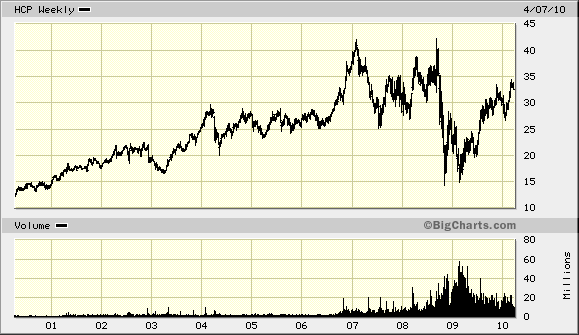Five Things to Look For in a Real Estate Investment Trust (REIT) Dividend Growth Investor
Post on: 28 Май, 2015 No Comment

Monday, April 8, 2013
Five Things to Look For in a Real Estate Investment Trust (REIT)
Real estate investment trusts (REITS) represent a unique opportunity for dividend growth investors. They provide exposure to real estate, without the hassle of direct ownership. REITs are structured as trusts for tax reasons, and as a result, they do not pay federal income taxes at the entity level. The dividends they pay to shareholders are typically treated as ordinary income, and do not qualify for the preferential rate on qualified dividends. However, because income is taxed only at the shareholder level, there is more money for distributions to shareholders. In addition, a portion of your typical REIT distributions is non-taxable and it is treated as return of capital for tax purposes. This decreases shareholder’s basis in the stock. The return of capital portion is caused by depreciation expense. By law, Real Estate Investment Trusts have to distribute at least 90% of income to shareholders, in order to maintain their preferential tax status.
There are five factors I analyze at a REIT, before putting my money to work in the sector. I used three REITs I own in this exercise — Realty Income (O), Digital Realty Trust (DLR) and Omega Healthcare Investors (OHI):
Funds from Operations (FFO)
Earnings per share are not an adequate way to look at REITs. Instead, analysts use Funds from Operations (FFO). FFO is defined as net income available to common stockholders, plus depreciation and amortization of real estate assets, reduced by gains on sales of investment properties and extraordinary items. I like to look at the trends in Funds from Operations per share over the past five or ten years, in order to see if there is any fuel for dividend growth. The slow growth in FFO led me to sell my position in Universal Healthcare Realty Trust (UHT) in March.
I usually prefer to see growth in FFO/share over the past five and ten years. REITs are pass-through entities, which means they return almost all of their free cashflow to shareholders. As a result, they sell shares and bonds each year in order to fund their expansion projects. These projects usually cause an increase in total revenues and FFO, but because of the dilution to existing shareholders, I want to see growth in FFO/share. This shows me that new projects are accretive to the FFO for all the shareholders. In the table below, I have placed the trends in FFO/share for three REITs I own:
FFO Payout
For REITs, I use FFO Payout Ratio, which is calculated by dividing the dividend payment over the FFO/share. I usually prefer to see a REIT whose payout ratio is below 90%. While REIT revenues are typically stable, I want to have some margin of safety in the form of a lower FFO Payout Ratio. Ideally, it would be flat or trending down over time. An FFO ratio above 90% couple with slow growth in FFO/share could jeopardize distribution growth. In the table below, I have summarized the FFO payout trends in three REITs I own:
Occupancy and Tenant Diversification
Diversification is an important thing to have in any portfolio, as it offers some level of protection to the company when something unexpected happens. I usually scan through the list of top tenants, and make sure that they do not account for an extremely large portion of revenues. I define extremely large as somewhere above the range of 50% — 66% of revenues. In addition, I also want to see stable and hopefully growing occupancy percentages over time. The occupancy ratios vary somewhat for different REITs. For example, Realty Income has an occupancy ratio of 97%, Digital Realty Trust has an occupancy of almost 94%, whereas Omega Healthcare Investors has an occupancy rate of 84%. The top ten tenants account for 64% of Omega Healthcare Investors revenues, but 35% for Digital Realty’s revenues. The top ten tenants of Realty Income account for 37% of revenues.
Plans for growth

The fuel behind future distributions growth is growth in FFO/share. The growth in FFO/share is one of the factors that will determine whether distributions grow above the rate of inflation, stay flat or even worse — get cut or eliminated. I usually like to see a company that can manage to deploy capital raised in the public markets into projects that have attractive rates of return, have signed long-term leases and have escalation clauses that would allow them to charge higher rents over time. In terms of growth, Digital Realty Trust, Omega Healthcare and Realty Income all rely on strategic acquisitions of quality properties. Realty Income went one step further in 2012, when in completed the acquisition of American Realty Capital Trust. As a result, it was able to boost monthly distributions by 19.20% .
Debt, Cost of Capital and Risks
Understanding leverage is an important part of understanding REITs and risks behind REITs. Most Real Estate Investment Trusts pay for new projects either by issuing stock or issuing debt. If they issue too much debt and the projects do not work out as expected, the interest costs might eat into the profit. If it is difficult to renew the debt, or it gets more expensive, this could eat into the profit as well. This is why it is important to review the maturity schedules for the REITs you are interested in analyzing. Currently, issuing debt is very cheap, which should bode well for various projects. When the debt has to be refinanced in ten years however, it would likely cost much more to renew it. Realty Income, Digital Realty Trust and Omega Healthcare Investors do not seem to have problem accessing capital markets, nor do they have steep amounts of debt maturing soon. Omega Healthcare sold 12 year bonds in 2012 at 5.875%, while Realty Income managed to sell $450 million notes maturing in 10 years at 3.25%. Realty Income also sold 5 year notes, which yielded 2%. Digital Realty Trust sold 12 year, 400 million British Pound notes at 4.25%. Digital Realty, also managed to sell 300 million in ten year notes at 3.625%.
Dividend Growth
The table below shows the dividend growth for Realty Income, Digital Realty Trust and Omega Healthcare Investors.
I prefer to look for consistent dividend growth over time. A long streak of dividend increases for at least ten years is important. A company that manages to maximize existing investment opportunities for the benefit of growing distributions to shareholders is the right company for my money. Although dividend cuts in the past cause a red flag, if the company has managed to build a ten year streak of dividend increases, and has FFO growth coupled with adequate levels of debt, I would take a chance on it.














